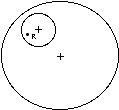Trig Application: Indirect Height Calculations
- Develop a formula for finding height "h" of a park landmark
(e.g., Star Tower) using two known angles taken "d"
distance apart along a horizontal line extending from the base
of the landmark.

- Use indirect measurement as diagrammed at right to calculate the height of two landmarks in the park. Include the name of the landmark, the portion of the structure for which you are finding height, your data and your calculations. Explain how you determined the distance "d," and include appropriate units with your calculations and answers.
Dual-Axis Rides: Angular and Linear Velocities
Observe one of the dual-axis rides where riders are positioned on a small circular platform mounted on a larger circular base. When the ride is in motion, both platforms revolve. On the illustration, indicate the direction of rotation for each circular platform, and estimate the distances from centers to rider on the small platform between centers of the two platforms.

- When the ride is at full speed, how long does it take for
each platform to make one revolution about its center?
- Illustrate the position of the rider with respect to both
platforms at the time when the rider's velocity is (a) the sum
of same-direction velocities; (b) a sum of opposite-direction
velocities; and (c) a right-triangle composition of
velocities.
- Calculate the angular and linear speeds of the rider at each position (2a), (2b) and (2c), above.
Free-Fall Distance, Velocity & Acceleration
Observe a ride in which the rider experiences vertical free-fall.
- Collect data or determine measures related to free-fall.
- Time the free-fall portion of the ride.
- Determine the maximum height of the rider's cabin and the vertical distance of free-fall using indirect measurement techniques.
- Use your vertical distance result to calculate time of free-fall.
- Compare answers in parts (1a) and (1c). Explain which
answer you believe to be more nearly accurate and why.
- Determine the maximum vertical velocity of the rider in
free-fall.
- If a park worker participating in pre-opening day testing
tossed a water balloon horizontally outward at a speed of 10
ft/sec from the very top of the ride at the very moment the
worker's cabin began its descent, how far from the base of the
ride would the water balloon land?
Click here for Word version
Click here for pdf version
Updated
1/28/2012